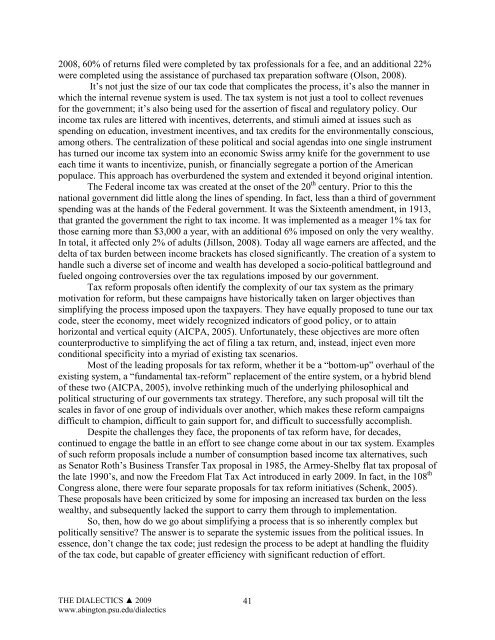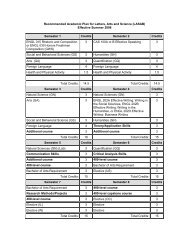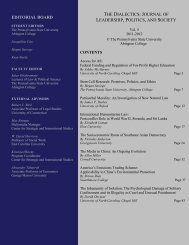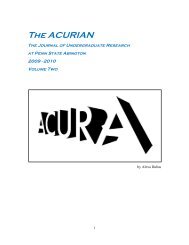Vol. III - Penn State Abington
Vol. III - Penn State Abington
Vol. III - Penn State Abington
Create successful ePaper yourself
Turn your PDF publications into a flip-book with our unique Google optimized e-Paper software.
2008, 60% of returns filed were completed by tax professionals for a fee, and an additional 22%<br />
were completed using the assistance of purchased tax preparation software (Olson, 2008).<br />
It’s not just the size of our tax code that complicates the process, it’s also the manner in<br />
which the internal revenue system is used. The tax system is not just a tool to collect revenues<br />
for the government; it’s also being used for the assertion of fiscal and regulatory policy. Our<br />
income tax rules are littered with incentives, deterrents, and stimuli aimed at issues such as<br />
spending on education, investment incentives, and tax credits for the environmentally conscious,<br />
among others. The centralization of these political and social agendas into one single instrument<br />
has turned our income tax system into an economic Swiss army knife for the government to use<br />
each time it wants to incentivize, punish, or financially segregate a portion of the American<br />
populace. This approach has overburdened the system and extended it beyond original intention.<br />
The Federal income tax was created at the onset of the 20 th century. Prior to this the<br />
national government did little along the lines of spending. In fact, less than a third of government<br />
spending was at the hands of the Federal government. It was the Sixteenth amendment, in 1913,<br />
that granted the government the right to tax income. It was implemented as a meager 1% tax for<br />
those earning more than $3,000 a year, with an additional 6% imposed on only the very wealthy.<br />
In total, it affected only 2% of adults (Jillson, 2008). Today all wage earners are affected, and the<br />
delta of tax burden between income brackets has closed significantly. The creation of a system to<br />
handle such a diverse set of income and wealth has developed a socio-political battleground and<br />
fueled ongoing controversies over the tax regulations imposed by our government.<br />
Tax reform proposals often identify the complexity of our tax system as the primary<br />
motivation for reform, but these campaigns have historically taken on larger objectives than<br />
simplifying the process imposed upon the taxpayers. They have equally proposed to tune our tax<br />
code, steer the economy, meet widely recognized indicators of good policy, or to attain<br />
horizontal and vertical equity (AICPA, 2005). Unfortunately, these objectives are more often<br />
counterproductive to simplifying the act of filing a tax return, and, instead, inject even more<br />
conditional specificity into a myriad of existing tax scenarios.<br />
Most of the leading proposals for tax reform, whether it be a “bottom-up” overhaul of the<br />
existing system, a “fundamental tax-reform” replacement of the entire system, or a hybrid blend<br />
of these two (AICPA, 2005), involve rethinking much of the underlying philosophical and<br />
political structuring of our governments tax strategy. Therefore, any such proposal will tilt the<br />
scales in favor of one group of individuals over another, which makes these reform campaigns<br />
difficult to champion, difficult to gain support for, and difficult to successfully accomplish.<br />
Despite the challenges they face, the proponents of tax reform have, for decades,<br />
continued to engage the battle in an effort to see change come about in our tax system. Examples<br />
of such reform proposals include a number of consumption based income tax alternatives, such<br />
as Senator Roth’s Business Transfer Tax proposal in 1985, the Armey-Shelby flat tax proposal of<br />
the late 1990’s, and now the Freedom Flat Tax Act introduced in early 2009. In fact, in the 108 th<br />
Congress alone, there were four separate proposals for tax reform initiatives (Schenk, 2005).<br />
These proposals have been criticized by some for imposing an increased tax burden on the less<br />
wealthy, and subsequently lacked the support to carry them through to implementation.<br />
So, then, how do we go about simplifying a process that is so inherently complex but<br />
politically sensitive The answer is to separate the systemic issues from the political issues. In<br />
essence, don’t change the tax code; just redesign the process to be adept at handling the fluidity<br />
of the tax code, but capable of greater efficiency with significant reduction of effort.<br />
THE DIALECTICS ▲ 2009<br />
www.abington.psu.edu/dialectics<br />
41







